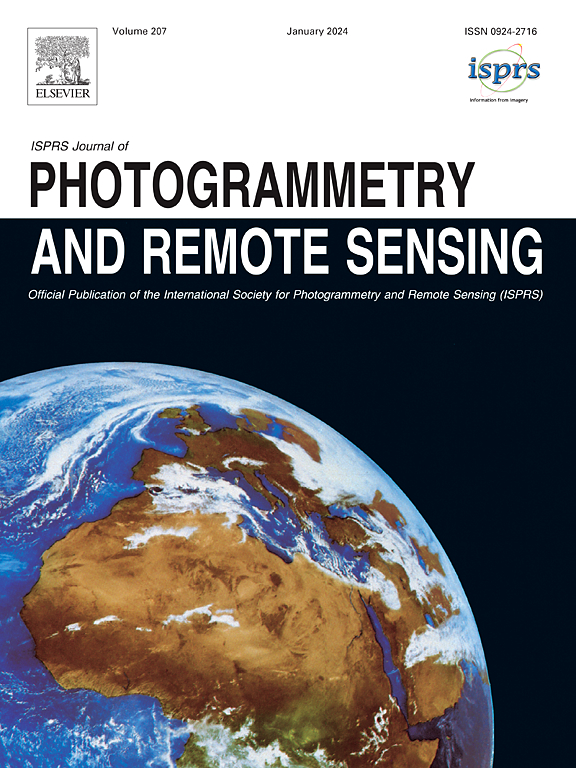Detection of buildings with potential damage using differential deformation maps
IF 10.6
1区 地球科学
Q1 GEOGRAPHY, PHYSICAL
ISPRS Journal of Photogrammetry and Remote Sensing
Pub Date : 2024-10-18
DOI:10.1016/j.isprsjprs.2024.10.008
引用次数: 0
Abstract
The European Ground Motion Service (EGMS) is a crucial component of the systematic monitoring and quantification of land displacement across Europe. By using Sentinel-1 full-resolution images, EGMS offers a reliable, consistent, and annually updated dataset for detecting natural and anthropogenic ground motion phenomena. While the Copernicus platform grants free accessibility to EGMS displacement maps containing a massive number of measurement points, the challenge lies in finding appropriate methodologies and tools to make this wealth of information easily exploitable, especially to non-experts. This study leverages the EGMS displacement maps to display the capability of a novel software tool designed for the automatic identification of urban structures that may be susceptible to damage due to differential movements. This approach is notable since it can be applied to areas of any size, from local to national scale, and while designed for EGMS data, it can be applied to any other InSAR-derived displacement maps, regardless of the data source. Despite prior researches on differential settlements, this study concentrates on analysing every single buildings and computing the spatial gradient of deformation by using Measurement Points specifically associated with each building. The designed software tool quickly analyses and detects at-risk buildings, applying a classification system that categorizes them based on the severity of their spatial deformation gradient, with uncertainty as the primary factor, and generates a differential deformation map as a result. The Monte Carlo simulations assisted us in estimating the standard deviation of the spatial gradient, which was determined to be 0.05 mm×yr−1×m−1. The approach was tested with EGMS data over the area of Barcelona Municipality (Spain) from 2017 to 2021. The complete source code is available at https://github.com/saeedehshahbazi/detecting-differential-deformation.git. In addition, a COSMO-SkyMed dataset was used to assess and appraise its performance. The number of detected buildings was 149 in the EGMS dataset and 155 in the COSMO-SkyMed dataset, with approximately 50% of the buildings classified as Very-Low/Low in both datasets. The results demonstrate the technique’s robustness, as it yielded consistent outcomes using distinct datasets. To verify the differential deformation map, a field survey was conducted to observe any evident structural damage (e.g., cracks or fractures). The differential deformation maps may represent a primary source of information for conducting a comprehensive analysis and vulnerability/risk assessment in urban areas. The effectiveness of this technique, as evidenced by consistent outcomes with diverse datasets, underlines its value in improving our understanding of structural vulnerabilities, thus contributing to informed urban management.
利用差异变形图探测可能受损的建筑物
欧洲地动仪服务(EGMS)是系统监测和量化整个欧洲土地位移的重要组成部分。通过使用哨兵 1 号全分辨率图像,欧洲地动服务为探测自然和人为地动现象提供了可靠、一致且每年更新的数据集。虽然哥白尼平台允许免费访问包含大量测量点的 EGMS 位移地图,但挑战在于找到适当的方法和工具,使这些丰富的信息易于利用,尤其是对非专业人员而言。本研究利用 EGMS 位移图展示了一种新型软件工具的能力,该工具设计用于自动识别可能因位移差异而受损的城市结构。这种方法的显著特点是,它可以应用于任何规模的地区,从地方到全国范围,虽然是针对 EGMS 数据设计的,但也可以应用于任何其他 InSAR 衍生的位移图,而不受数据来源的限制。尽管之前已有关于差异沉降的研究,但本研究侧重于分析每一栋建筑物,并通过使用与每栋建筑物相关的测量点来计算变形的空间梯度。所设计的软件工具可快速分析和检测有风险的建筑物,应用分类系统根据其空间变形梯度的严重程度进行分类,并将不确定性作为主要因素,从而生成差异变形图。蒙特卡罗模拟帮助我们估算了空间梯度的标准偏差,确定为 0.05 mm×yr-1×m-1。该方法利用 2017 年至 2021 年巴塞罗那市(西班牙)地区的 EGMS 数据进行了测试。完整的源代码见 https://github.com/saeedehshahbazi/detecting-differential-deformation.git。此外,还使用了 COSMO-SkyMed 数据集来评估和评价其性能。在 EGMS 数据集中检测到的建筑物数量为 149 座,在 COSMO-SkyMed 数据集中检测到的建筑物数量为 155 座,在这两个数据集中约有 50% 的建筑物被归类为极低/低。这些结果证明了该技术的稳健性,因为它在不同的数据集上产生了一致的结果。为了验证差异变形图,我们进行了实地调查,以观察是否有明显的结构损坏(如裂缝或断裂)。差异变形图可能是在城市地区进行综合分析和脆弱性/风险评估的主要信息来源。这一技术的有效性体现在对不同数据集的一致结果上,突出了它在提高我们对结构脆弱性的认识方面的价值,从而有助于进行知情的城市管理。
本文章由计算机程序翻译,如有差异,请以英文原文为准。
求助全文
约1分钟内获得全文
求助全文
来源期刊

ISPRS Journal of Photogrammetry and Remote Sensing
工程技术-成像科学与照相技术
CiteScore
21.00
自引率
6.30%
发文量
273
审稿时长
40 days
期刊介绍:
The ISPRS Journal of Photogrammetry and Remote Sensing (P&RS) serves as the official journal of the International Society for Photogrammetry and Remote Sensing (ISPRS). It acts as a platform for scientists and professionals worldwide who are involved in various disciplines that utilize photogrammetry, remote sensing, spatial information systems, computer vision, and related fields. The journal aims to facilitate communication and dissemination of advancements in these disciplines, while also acting as a comprehensive source of reference and archive.
P&RS endeavors to publish high-quality, peer-reviewed research papers that are preferably original and have not been published before. These papers can cover scientific/research, technological development, or application/practical aspects. Additionally, the journal welcomes papers that are based on presentations from ISPRS meetings, as long as they are considered significant contributions to the aforementioned fields.
In particular, P&RS encourages the submission of papers that are of broad scientific interest, showcase innovative applications (especially in emerging fields), have an interdisciplinary focus, discuss topics that have received limited attention in P&RS or related journals, or explore new directions in scientific or professional realms. It is preferred that theoretical papers include practical applications, while papers focusing on systems and applications should include a theoretical background.
 求助内容:
求助内容: 应助结果提醒方式:
应助结果提醒方式:


